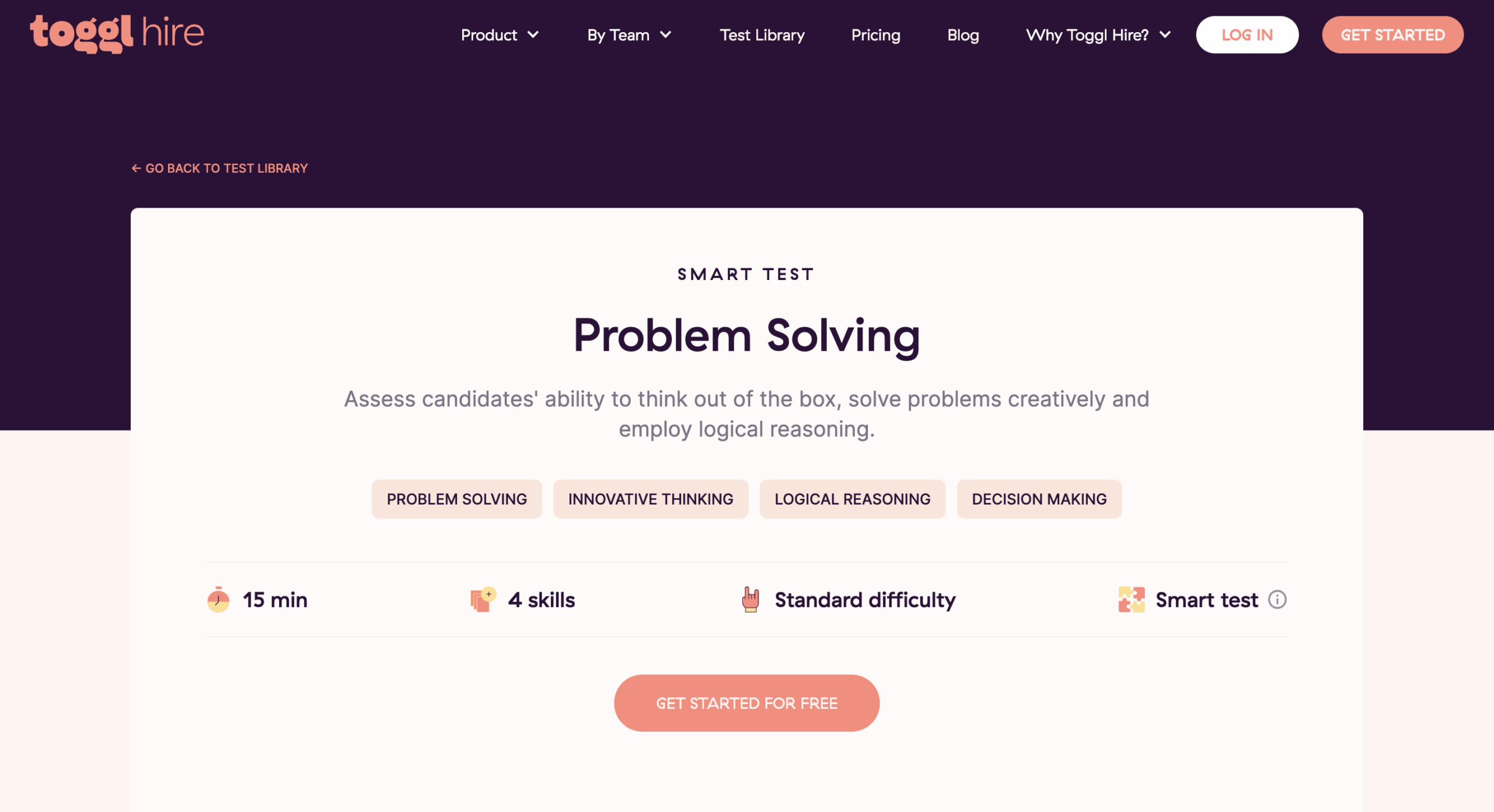Knowing how to hire employees with strong problem-solving skills can make all the difference in becoming the next Netflix – or Blockbuster.
Because every role, from the penthouse corner office to the high street, involves a degree of problem-solving. Whether managing a team, developing a web page, or resolving a customer complaint, what matters is how people deal with the problems they face.
To ensure your company is prepared to tackle even the most challenging situations, we’ll first look at what problem solving skills are, using some real-life applications, before walking you through 5 of the best ways to test for them.
TL;DR – Key Takeaways
- Problem-solving skills encompass all the skills that employees use in the workplace to analyze problems and come up with solutions.
- Examples of typical problem-solving skills include good communication skills, active listening skills, decision-making skills, analytical skills, creativity, and collaboration.
- Different problem-solving skills are required from a manager compared to an individual contributor, so hiring managers should look for different competencies according to the seniority of the role.
- There are several ways to assess a candidate’s problem-solving skills when hiring, such as asking behavioral interview questions, running assessment tests or job simulations, conducting reference checks, and asking cultural fit questions.
- Toggl Hire has an impressive library of customizable skills tests and homework assignments that hiring managers can plug into their hiring pipeline to help identify the best problem-solvers right from the start.
What are problem-solving skills?
“Problem solving skills” refers to someone’s ability to identify problems, analyze possible solutions, and think through the steps required to solve those problems. For example, an HR specialist faced with the problem of filling a new position might first analyze whether it would be best filled internally or externally before posting a job description.
Problem solving skills are critical for every possible industry, role, and level of seniority, because at the bottom of each job is solving some type of problem.
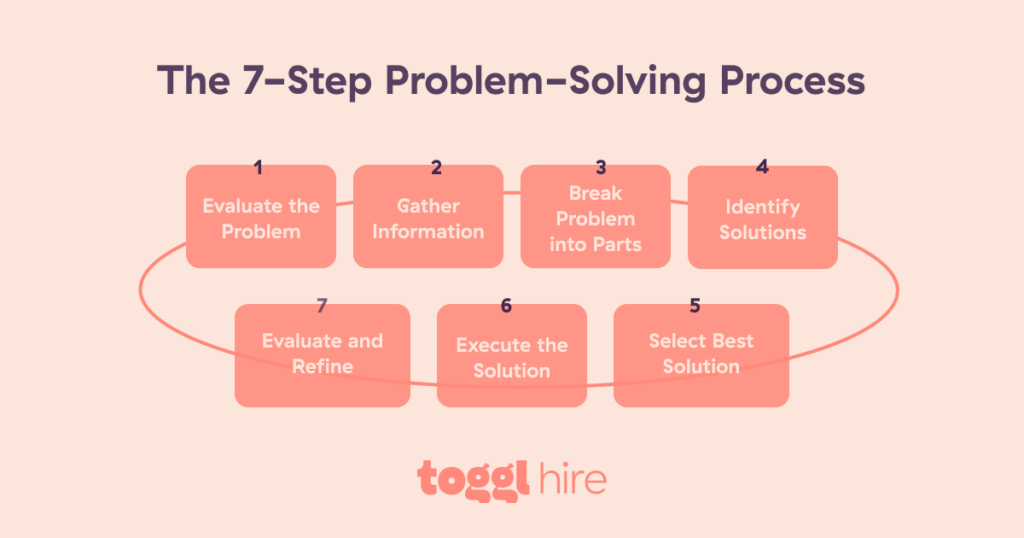
Examples of typical problems in the workplace include:
- Finding out the reason behind increased customer complaints
- Improving the efficiency of outbound cold calls for your sales team
- Overhauling a landing page so that it drives more people to subscribe to a software
As you can see, every possible role that exists requires people to solve problems effectively.
What skills make up the problem-solving competency?
“Problem solving skills” is an umbrella term that covers a wide variety of different skills. Here are some examples of typical problem solving abilities that an employee may need for any given role:
- Communication skills
- Decision-making skills
- Research skills
- Analytical skills
- Creativity
- Collaboration
- Active listening skills
Not all of them are necessary for every role, but these examples of hard and soft skills are a great starting point if you’re putting together a job description for your next role.
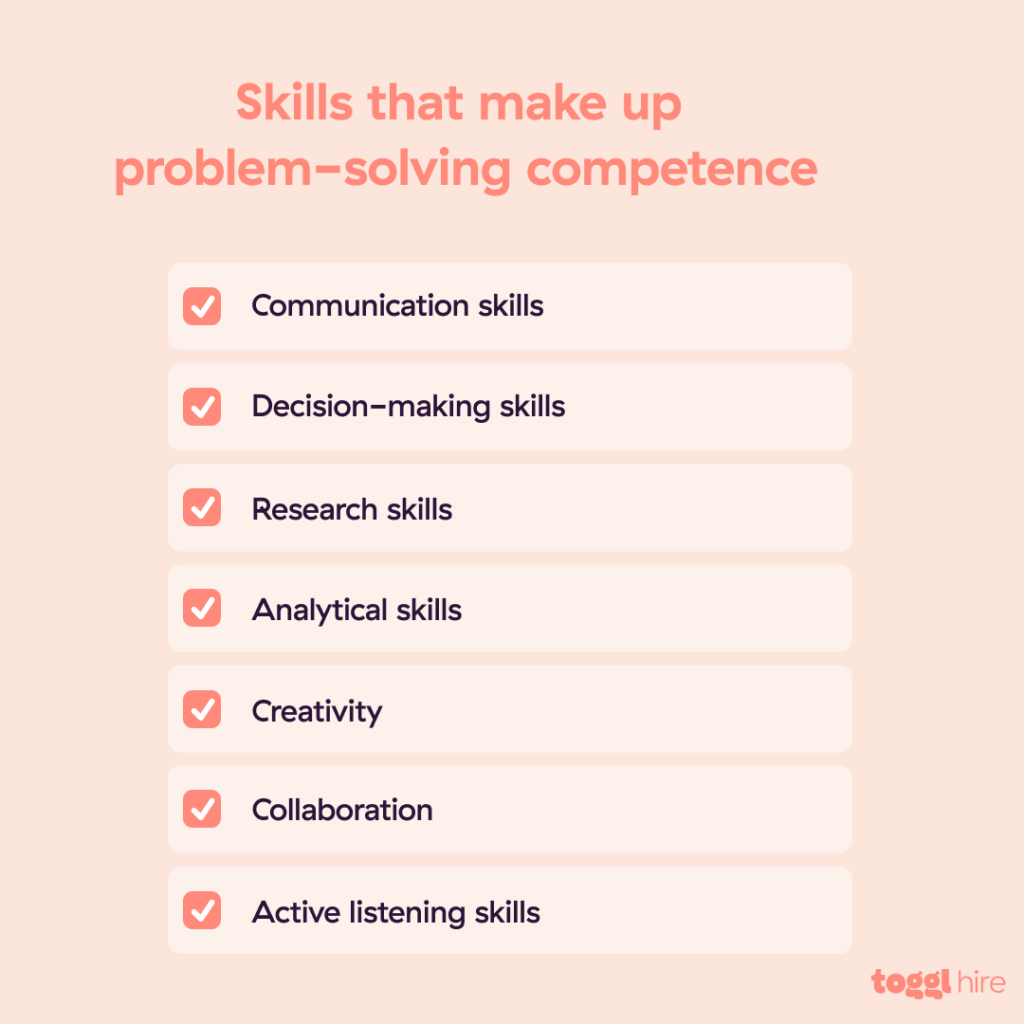
Problem-solving skills examples at different levels
In addition to the variety of skills that fall under the term “problem-solving”, there are also different competency levels of problem-solving.
Just like the difference between hiring an intern, a manager, and a director, choosing the right level of problem-solving competency will depend on the role you’re hiring for.
To explain this further, let’s dig into the 3 basic levels of problem-solving skills.
Entry-level problem-solving skills
A candidate with entry-level problem-solving skills is capable of identifying what the problem is and considering the potential solution. However, they struggle to move beyond this point. These types of skills are suitable if you’re looking to hire for a junior position.
Intermediate-level problem-solving skills
At an intermediate level, the candidate not only identifies problems and finds potential solutions for them, but also uses different types of problem-solving skills and strategies to tackle them from different angles.
However, for more complex problems, they might struggle to implement the solution and will look for assistance from other team members.
Expert-level problem-solving skills
At an expert level, a candidate is capable of solving problems from beginning to end. They are skilled in different problem-solving strategies, including how to gather and analyze relevant information. They are able to see creative solutions where others do not and can anticipate potential obstacles before they happen.
Why are problem-solving skills so important at work?
The modern workplace is full of problems that need solving. Solution-focused employees are a valuable asset to any company in any possible role. They help your company save money, keep customers happy, and inspire colleagues by coming up with new ways to solve old problems.
Employers like to see good problem-solving skills because it also helps to show them you have a range of other competencies such as logic, creativity, resilience, imagination, lateral thinking, and determination.
Here are some of the benefits amazing problem solvers bring to an organization and those around them:
Problem-Solvers Work Well Under Pressure
When a problem arises, it needs to be fixed quickly. Employees with amazing problem-solving skills roll with the punches and tight deadlines to deliver when it matters.
To do this, expert problem-solvers react quickly to short-term situations while thinking proactively about future problems. That ability to act fast and effectively exuberates confidence, creating a sense of calm across the wider team.
They Create Amazing New Ideas
Problem-solving and creative thinking go hand-in-hand. The best problem-solvers don’t just put bandaids over an issue, they fix them in a dynamic, value-adding way.
Exciting, out-of-the-box thinking isn’t just good in the moment but creates an exciting, innovative culture across the organization. That helps organizations stay ahead of the curve and attracts other expert problem-solvers to join the organization, improving the workforce’s capability over time.
Problems Create Risk, and Problem-Solvers Fix Problems
From an organizational perspective, problems create risk. Even if a business process is slightly off-kilter, it can become a much greater issue.
Problem-solvers help organizations reduce risk in the moment while mitigating future risks before they even occur. That helps everyone sleep sounder at night and also removes financial liability from the C-suite.
Problem-Solvers Beat The Competition
Ultimately, excellent problem-solvers help organizations stay ahead of their competition. Whether through creative ideas, faster outputs, or reduced risk, organizations with awesome problem solvers deliver better products and services to their clients.
As we all know, it’s the people that make an organization great, and problem-solvers are some of the best people out there!
Next, let’s take a closer look at how problem-solving skills may differ between individual contributors and managers.
Example of using problem-solving skills in the workplace: manager vs individual contributor
While their approaches may differ, both the manager and the individual contributor go through the same stages of the problem-solving process.
Managers look at the broader perspective of solving a problem and the different ways of coordinating their team and the organization. Their focus is the long-term success of their team and the company.
The individual contributor, on the other hand, is more concerned with individual tasks and technical problems, as well as instant solutions to a problem at hand.
Both sides of the coin are important if you want to succeed at problem solving in the long run and thrive as a team and as a company.
Step 1 – Problem definition
| Manager | Individual Contributor |
|---|---|
| Focuses on looking at larger, organizational goals and team dynamics. Looks at the long-term impacts of solving a problem. | Focuses on the specific details of solving a problem at hand. Is not concerned with collaboration as much. Looks at the short-term impact of resolving an issue. |
Quick example – A Sales Exec goes to their manager with a problem – they’re struggling to hit their sales target. The Sales Manager sits down with them to understand the situation, where they are with their sales, and the gap to the target.
Step 2 – Problem analysis
| Manager | Individual Contributor |
|---|---|
| Needs strong analytical skills and the ability to align the solution to a problem with the overall team and company goals. | Analyzes the problem at hand from a technical standpoint. Considers their individual role in solving a problem. Does not look into collaboration as a way to facilitate problem solving. |
Quick example – The Sales Manager goes away and gathers some information about the Sales Exec. They look at their CRM notes, speak with other team members, and shadow the Sales Exec on the job.
Step 3 – Generating the possible solutions
| Manager | Individual Contributor |
|---|---|
| Focuses on creativity and ensures that the solutions they come up with align with the broader, organizational goals. | They have more autonomy in choosing how to go about the problem solving. Since they have domain expertise, they apply their knowledge to a specific challenge without considering the broader implications of their work. |
Quick example – The Sales Manager comes up with some solutions to help their Sales Exec. Options on the table include additional training, a structured work plan, and re-prioritizing their workload.
Step 4 – Implementing the best solution(s)
| Manager | Individual Contributor |
|---|---|
| Besides problem solving skills, needs a strong grip on project management, time budgeting, and aligning with the overall goals of the company. | Only focuses on solving the problem at hand as quickly and effectively as possible. Aligns with their own goals or the goals of their immediate team. |
Quick example – The Sales Manager lays out the next steps with the Sales Exec, explaining the proposed solutions. The Sales Exec will do some re-training on the sales process and will re-prioritize their workload to focus on particular, high-value customers.
5 Ways to Evaluate Problem-Solving Skills When Hiring
There are many practical ways to evaluate how people solve problems during the hiring process. Depending on your needs, you can use one, more, or all of these in combination.
#1 – Behavioral interview questions
These are questions you ask candidates to find out how they solved problems in the past and behaved in a certain situation. Here are some examples:
- How do you handle setbacks at work?
- A customer came back to you with a complaint and the fault is on your company’s end. How do you resolve the issue?
- Your employees have a conflict and you need to resolve it without taking sides. How do you go about this?
- You have a certain timeframe to complete a complex task. How do you prioritize the work to ensure you meet the deadline and not burn out?
You can use the STAR method to assess how they solve problems in specific situations:
S – Situation: how well did they explain the situation they faced?
T – Task: what was the task they had to complete in that situation?
A – Action: did they clearly show the action they took to resolve the problem?
R – Result: how did they explain the result, and measure success?
With the right set of questions and the application of the STAR method, you can see if your candidates have good problem solving skills or not. However, this method is not 100% reliable as your candidates could be less than honest in their responses, which brings us to the other methods.
#2 – Job simulation exercises
Instead of asking candidates to think of past experiences, you can put them in a real-life situation to judge how they think and react in real time. And see for yourself how analytical, creative, and competent they are. The best way to do this is with a simulation exercise.
Note that these job simulation tasks only resemble what the candidate will be doing in their job but shouldn’t include real data or customers to protect your business.
One such example is our Homework assessments. Designed as an assessment tool for hiring managers, Homework assessments offer 500 pre-built tasks you can give to potential candidates before inviting them for an interview or extending an offer.
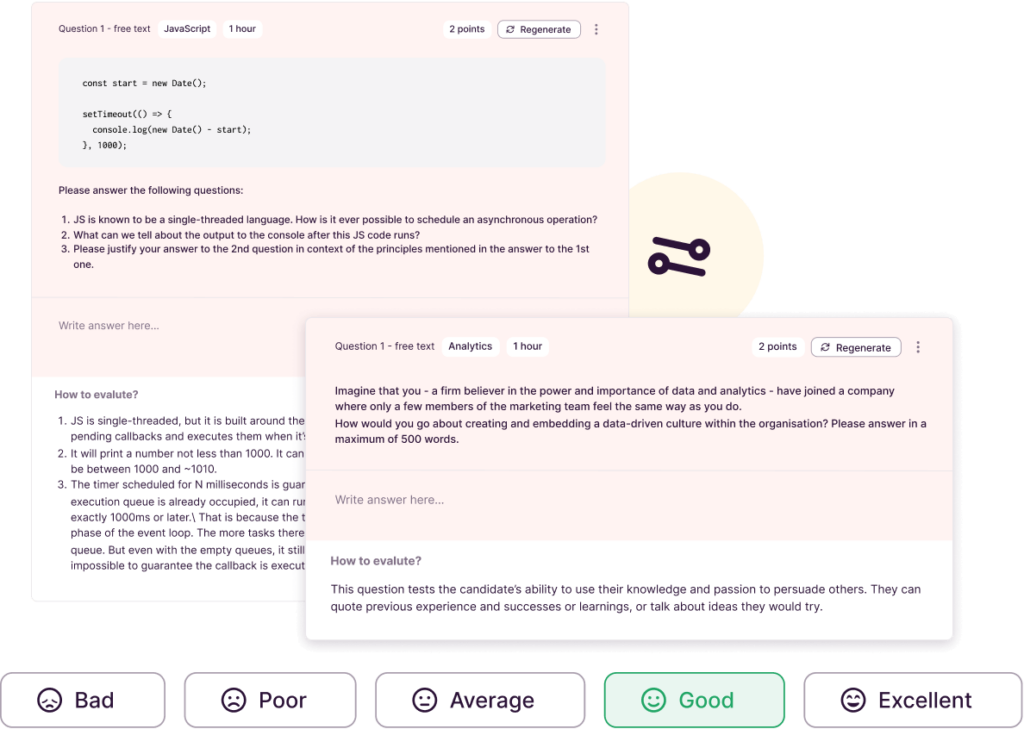
Candidates can do these tasks on their own and in their free time. In our library, you can choose from a variety of tasks where candidates can show off their analytical skills and proficiency in solving problems.
Once they’re done, you can review the tasks and create shared notes for your entire team to review. Just like that, you’re one step closer to making a more confident hiring decision, and your candidates can practice solving problems without causing risks for your ongoing work.
#3 – Assessment tools
Putting candidates in different situations is a solid way to find out more about their problem solving skills. However, another fantastic way to see how they solve problems is by using skills assessment tools.
Tools like Toggl Hire allow you to create pre-employment tests often used in the first step of the hiring process. That way, you can tell early on how good someone is at solving problems and whether they have the key skills to meet the requirements for the job.
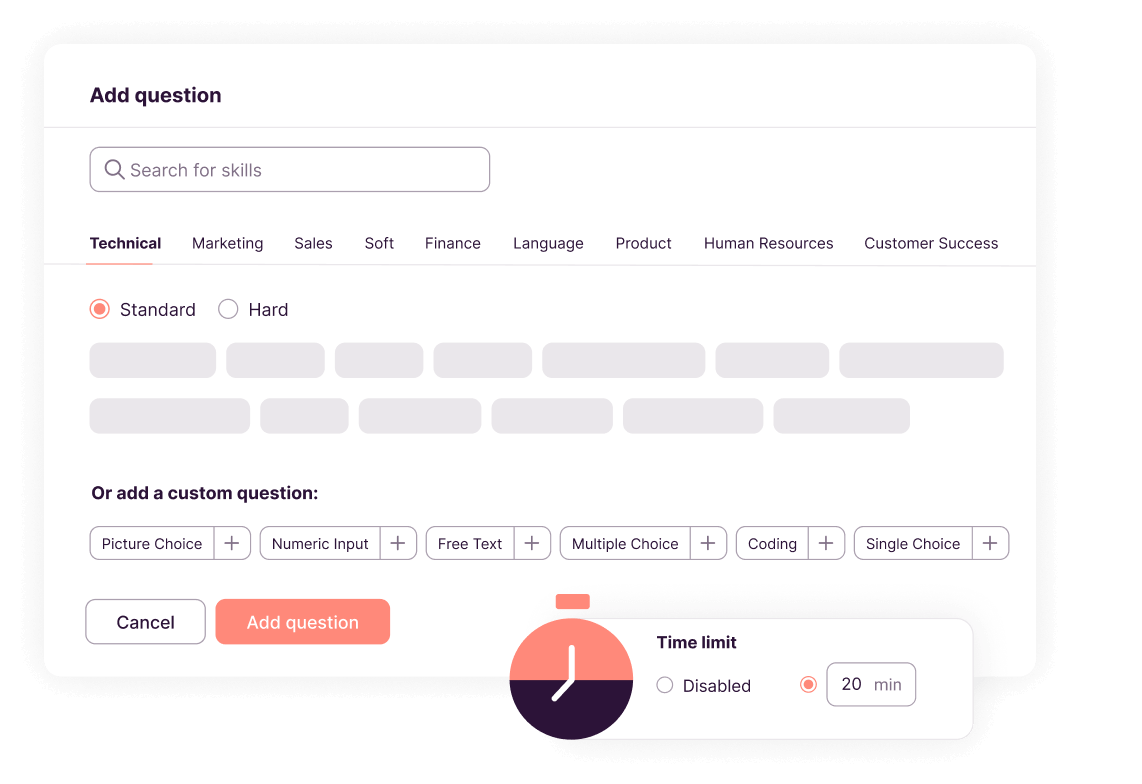
In our problem-solving skills test, we test for four crucial skills:
- Problem solving
- Innovative thinking
- Logical reasoning
- Decision making
Problem solving assessment template
The assessment takes only 15 minutes, making it a great alternative to submitting a resume and cover letter. Applicants love Toggl Hire because they get feedback rapidly, and know within minutes of completing the test if they are a good fit for the role. [Grab the template here]
#4 – References and past performance
Reference checking is a simple but effective way to evaluate the skills of potential candidates. To understand if someone has the right problem-solving skills for the job, simply ring up their past employers and ask!
The more specific your questions, the better. Ask about objectives and goals that they completed that stand out during their time with the company. Moreover, you need to make sure that they have a pattern in their performance. In other words, were they consistent in finding new ways to solve problems and tackle complex issues?
A word of caution.
References are not always reliable. Past employers may refuse to comment on an employee’s performance, or they could be forbidden from doing so by their contracts. Sometimes, you may be unable to get ahold of the point of contact. Other times, their feedback can be overly positive.
This is why it’s important to consider other possible solutions for assessing problem solving skills in combination with reference checks.
#5 – Cultural fit
When you have all of this information in one place, it’s time to find the last piece of the puzzle. In other words, to see if the way a candidate solves problems aligns with your values and company culture.
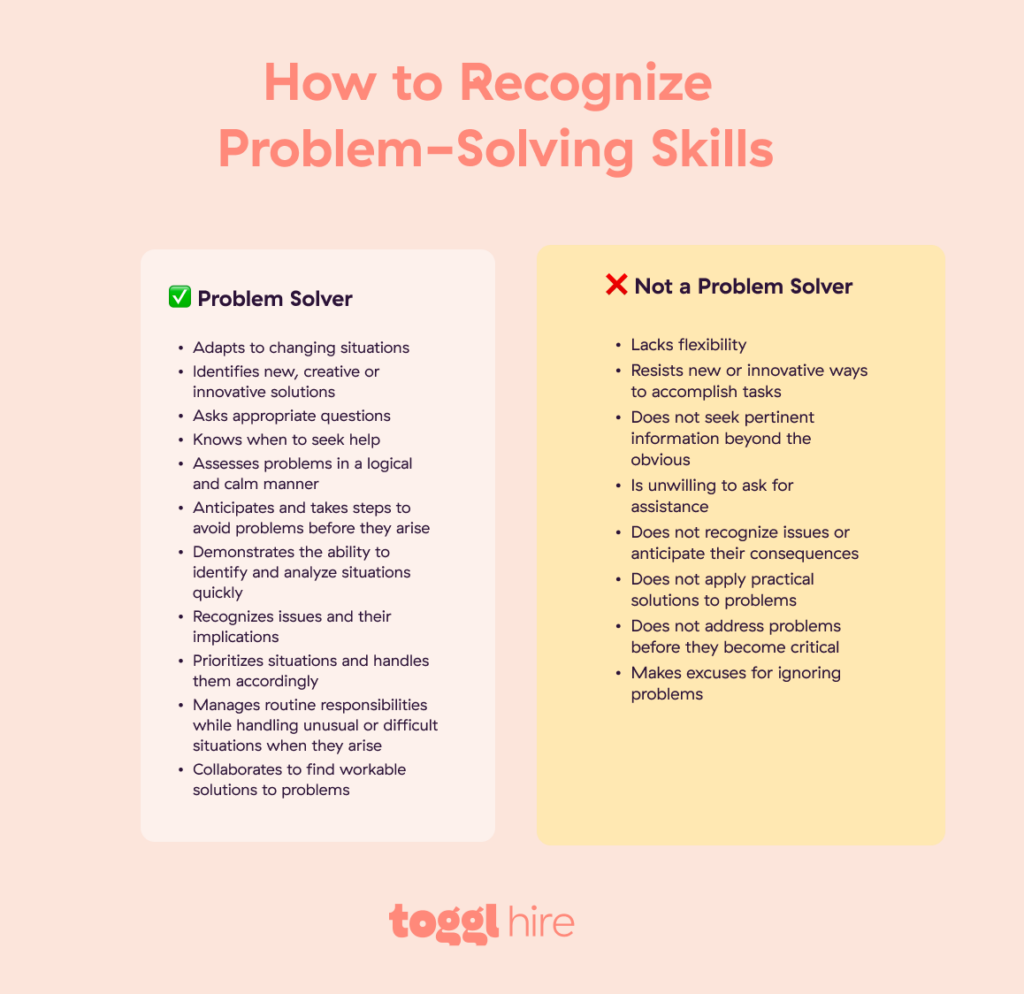
For example, you may have a customer who has a problem with their account and wants a full subscription refund. One approach to problem-solving, in this case, would be to give the full refund because the customer is right – no matter what.
On the other hand, someone else might try and talk to the customer and get them to stay. You can come up with different problem solving skills examples to inquire about during the interview stage.
The candidate should be able not just to solve problems, but also do it in a way that matches your company culture.
Wrapping up
Employees with great problem-solving skills will always be in demand, no matter the profession or seniority level. However, testing for those skills can present a challenge for recruiters.
With the right tools, problem solving interview questions, and reference checks, you can determine if a candidate is a good problem solver or not.
If you need a bit more guidance on how to test for problem solving skills, try a ready-made Toggl Hire skills test to quickly screen candidates and determine who will continue to the job interview.
Juste loves investigating through writing. A copywriter by trade, she spent the last ten years in startups, telling stories and building marketing teams. She works at Toggl Hire and writes about how businesses can recruit really great people.







